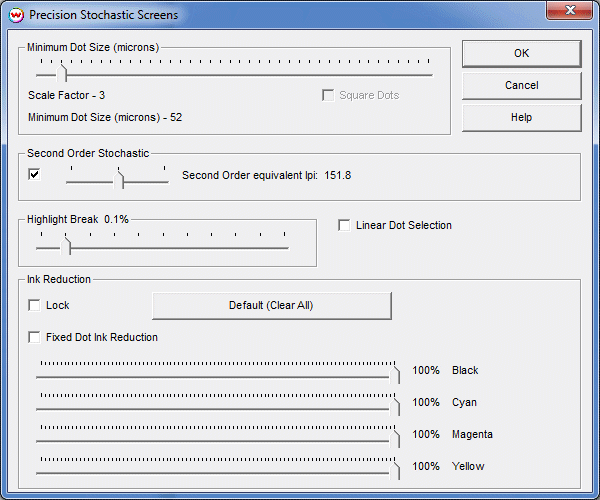

"Random Dot" or "FM" screening is the most powerful method available for eliminating moiré in all printing processes. Without these screening methods, digital color inkjet printing would not exist at all. For screen printers, nothing else has the potential of FM screening for eliminating output moiré.
 |
 |
Precision Stochastic Screens is an FM halftoning method with controls for adjusting nominal dot size to be adjusted in terms of microns. This provides powerful control for the use of FM halftoning for screen and flexo printing. Access this control by selecting the Precision Stochastic Screens halftoning method on the Color Transforms screen and clicking on Halftone Properties. Change the minimum dot size using the slider.

Illustration 3: Stochastic Screen controls
Do not change the Ink Reduction sliders from their 100% defaults. These controls are intended strictly for color printing with FM screens. Any change from 100% will cause problems for the production of films.
The Minimum Dot Size control rescales the halftoning function to enlarge dots, and allows the adjustment of dot size in microns. This is illustrated by the three gradients shown below. Enlargement of dots creates a "coarser" print, but it is commonly needed to create a "printable" separation. This also provides the benefit of drastically reduced dot gain. The effect of manipulating the dot size slider is shown belown for 1X, 2X, and 3X.
The Square Dots control affects the shape of dots formed when dot size is scaled. For devices where dpi is the same horizontally as vertically, this control is grayed out and does nothing.

1X

2X

3X
Basic "first order" Precision Stochastic Screens can be used for the production of separations for screen, flexo, and litho printing, but it has some limitations for that use due to dot gain, and to the limited reliabilty of reproducing tiny dots on press.
Both the problem with dot gain, and problems with reproduction of tiny dots, can be addressed with the type of "Second Order" stochastic screen illustrated by this screened gradient:

In this screen, unlike "first order" Precision Stochastic Screens, the size of the dots increases through the midtone, flattening out dot-gain curves, and alleviating problems related to printing tiny dots. All the benefits of FM screens' immunity to moiré is combined with the "printability" of an AM screen.
Activate Second Order with the check box, and adjust the "equivalent lpi" with the slider. This lpi figure is only a rough equivalence because in this method, dots are not arranged in lines. It states the lpi that would produce an equal number dots within a square inch if using an AM screen. This equates to a similar dot size, so that this number is predictive of "printability." Most printers will find they can use a higher equivalent lpi with this screen than the lpi they could use with an AM screen.
The equivalent lpi is a function of this control, of the "Minimum Dot Size" control, and of the dpi available from the printing device.
| Learn more about digital halftoning methods by visiting the Wasatch Website |